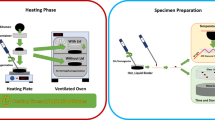Abstract
A technique based on Fourier Transform Infrared Spectroscopy-Attenuated Total Reflectance (FTIR-ATR) was developed and used to study movement of water into bitumen/substrate interfaces, as well as to characterize stripping. Bitumens from different sources were used and applied on various substrates (silicon, germanium and zinc selenide) as thin films. The influence of bitumen type, substrate type, temperature, film thickness and modification with amines, on water damage was studied. The technique gave information on water flow into interfaces and how stripping possibly occurs. It distinguished between stripping and non-stripping bitumens. At least one of three processes occurred, namely water diffusion, film fracture, and bitumen displacement by water, respectively. The diffusion of water did not obey Fick’s law. Stripping was influenced by bitumen source when silicon and germanium substrates were used. Notching the films made the process of water entry almost occur immediately. Additives significantly reduced stripping in the moisture-sensitive bitumen on silicon and germanium substrates, even after film notching. Although, good agreement was observed between tests for the bitumens that did not strip, the tests on stripping bitumens showed poor agreement.








Similar content being viewed by others
References
Majidzadeh K, Brovold FN (1968) Highway Res Board, Special Report 98
National Seminar on Moisture Sensitivity of Asphalt Pavements (2003), San Diego, CA, Feb 4–6
Bagampadde U, Isacsson U, Kiggundu BM (2004) J Road Mater Pavement Des 5(1):7–45
Plancher H, Dorrence SM, Petersen JC (1977) In: Proceedings of the Association of Asphalt Paving Technologists, vol 46. pp 151–175
Petersen JC, Plancher H (1998) J Petroleum Sci Technol, 16:89–131
Nguyen T, Byrd E, Bentz D, Seiler J (1992) In: SHRP-ID/UFR-92-611, National Research Council, Washington, D. C
Karlsson R, Isacsson U (2002) J Mater Civil Eng 15(2):157-165
http://www.webelements.com/webelements/elements/text/Si/chem.html, as on 14 Nov. 2005
http://www.webelements.com/webelements/elements/text/Ge/chem.html, as on 14 Nov. 2005
Acknowledgements
This work has been financially supported by Sida/SAREC of Sweden. The authors thank Professor Ulf Isacsson for his constructive ideas and criticism.
Author information
Authors and Affiliations
Corresponding author
Rights and permissions
About this article
Cite this article
Bagampadde, U., Karlsson, R. Laboratory studies on stripping at bitumen/substrate interfaces using FTIR-ATR. J Mater Sci 42, 3197–3206 (2007). https://doi.org/10.1007/s10853-006-0181-x
Received:
Accepted:
Published:
Issue Date:
DOI: https://doi.org/10.1007/s10853-006-0181-x




